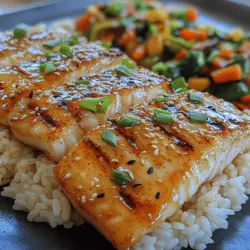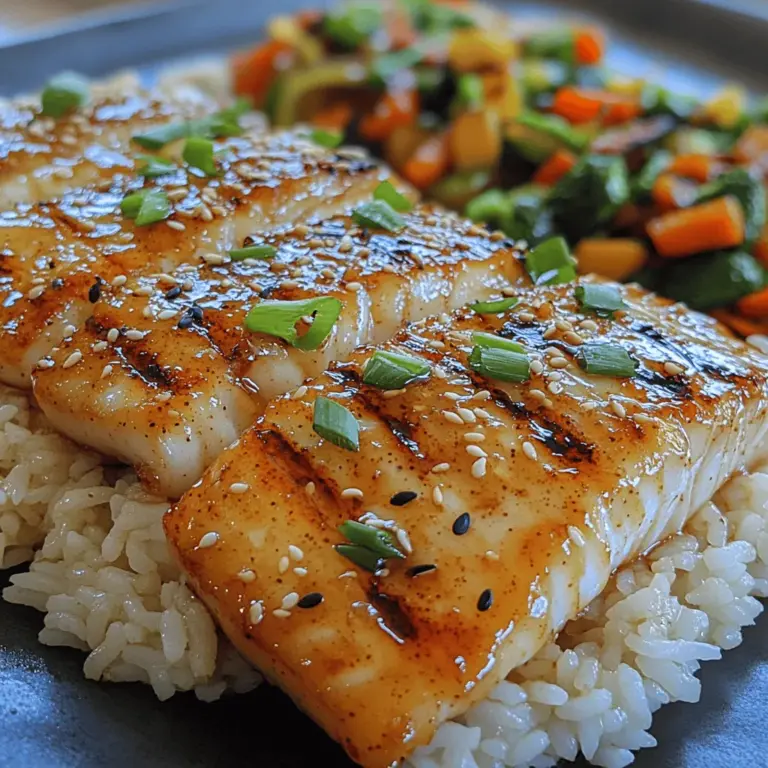Introduction
Mahi Mahi, also known as dolphinfish, is a versatile and flavorful fish option that has gained popularity among seafood enthusiasts and home cooks alike. With its firm texture and mildly sweet flavor, Mahi Mahi is perfect for grilling, baking, or pan-searing. In this Sweet Soy Glazed Mahi Mahi recipe, we will take this delightful fish and elevate it with a rich, Asian-inspired glaze that marries sweet and savory notes beautifully.
The sweet soy glaze is a standout feature of this dish, combining elements of traditional Asian cuisine with a modern twist. This glaze is easy to make and brings a depth of flavor that enhances the natural taste of the Mahi Mahi, making it a perfect choice for both weeknight dinners and special occasions. As you explore this recipe, you will discover how simple it is to create an impressive meal that is sure to impress family and friends.
In addition to its fantastic flavor, Mahi Mahi is also a nutritious choice. It is packed with high-quality protein and is an excellent source of omega-3 fatty acids, which are essential for heart health and overall well-being. By incorporating Mahi Mahi into your diet, you can enjoy not only a delicious meal but also the numerous health benefits that come with this remarkable fish.
Get ready to dive into a culinary experience that is both satisfying and wholesome. This Sweet Soy Glazed Mahi Mahi recipe is designed to be straightforward and approachable, making it a great option for cooks of all skill levels. So, gather your ingredients, and let’s start this delightful cooking journey together!
Understanding Mahi Mahi
Before we delve into the recipe, it’s essential to understand what makes Mahi Mahi such a unique and appealing fish. Mahi Mahi is known for its bright, golden skin and firm, flaky flesh, which makes it a popular choice among seafood lovers. The flavor profile of Mahi Mahi is mild yet slightly sweet, allowing it to absorb various marinades and sauces effectively. This quality makes it an ideal canvas for a wide range of culinary creations, from tropical-inspired dishes to more traditional seafood preparations.
When it comes to nutrition, Mahi Mahi stands out as a lean source of protein, making it an excellent choice for those looking to maintain a balanced diet. A typical serving of Mahi Mahi contains around 20 grams of protein and is low in calories, making it a great option for health-conscious eaters. Additionally, this fish is rich in omega-3 fatty acids, which are known for their anti-inflammatory properties and positive effects on heart health. These essential fats can help lower the risk of heart disease and support overall wellness.
As consumers become increasingly aware of the environmental impact of their food choices, the importance of sustainable fishing practices has come to the forefront. Choosing responsibly sourced Mahi Mahi helps protect marine ecosystems and ensures that future generations can enjoy this delicious fish. When purchasing Mahi Mahi, look for certifications from organizations that promote sustainable fishing practices, such as the Marine Stewardship Council (MSC). This way, you can enjoy your meal while contributing to the preservation of our oceans.
Mahi Mahi can be compared to other popular fish, such as salmon and tuna, but it has its distinct qualities that set it apart. While salmon has a richer, oilier texture, Mahi Mahi offers a firmer bite that holds up well to various cooking methods. Its mild flavor allows it to pair beautifully with a wide range of seasonings and sauces, making it a versatile option in the kitchen. Whether grilled, baked, or sautéed, Mahi Mahi remains a favorite among seafood lovers for its adaptability and deliciousness.
The Sweet Soy Glaze: Ingredients and Flavor Profile
The heart of this Sweet Soy Glazed Mahi Mahi recipe lies in the glaze itself, which combines a handful of simple yet impactful ingredients to create a deliciously complex flavor profile. Let’s break down each component of the glaze to understand how they contribute to the overall taste of the dish.
1. Soy Sauce: The foundation of the glaze, soy sauce, provides a rich umami flavor that enhances the natural taste of the Mahi Mahi. It adds depth and saltiness, which balances the sweetness of the other ingredients.
2. Honey: This natural sweetener brings a touch of sweetness to the glaze, complementing the salty notes of the soy sauce. Honey also adds a beautiful gloss to the fish, making it visually appealing once cooked.
3. Rice Vinegar: With its mild acidity, rice vinegar adds a refreshing tang to the glaze, helping to cut through the richness of the fish. This balance of flavors is essential in achieving a well-rounded dish.
4. Sesame Oil: A staple in Asian cooking, sesame oil infuses the glaze with a nutty aroma that elevates the overall flavor profile. A little goes a long way, so be sure to use it sparingly for maximum impact.
5. Garlic: Fresh garlic adds a pungent, aromatic quality to the glaze, enhancing the dish’s complexity. It infuses the fish with a delightful flavor that pairs perfectly with the sweetness of honey.
6. Ginger: Fresh ginger brings a zesty kick to the glaze. Its warm, spicy notes contribute to the dish’s overall appeal and add a layer of freshness that brightens the flavors.
The combination of these ingredients creates a harmonious blend of sweet, salty, and umami flavors that will tantalize your taste buds. The impact of using fresh ingredients cannot be overstated; fresh garlic and ginger bring a vibrancy that dried alternatives simply cannot match. The result is a glaze that not only enhances the Mahi Mahi but also leaves a lasting impression on anyone who tastes it.
Preparing for the Recipe
Before we jump into the cooking process, it’s essential to gather the necessary kitchen tools and prepare for a successful cooking experience. Here’s a list of essential kitchen equipment you’ll need for the Sweet Soy Glazed Mahi Mahi recipe:
– Grill or Oven: Depending on your preference, you can either grill the Mahi Mahi for a smoky flavor or bake it in the oven for a more straightforward approach. Both methods yield delicious results.
– Mixing Bowls: You’ll need a couple of mixing bowls for preparing the glaze and marinating the fish. Having the right-sized bowls on hand will make the process smoother.
– Measuring Cups and Spoons: Accurate measurements are crucial for achieving the perfect balance of flavors in your glaze. Use measuring cups and spoons to ensure you get the proportions just right.
– Whisk or Fork: A whisk or fork will be handy for mixing the glaze ingredients together, ensuring everything is well combined.
– Baking Sheet or Grill Pan: If you’re using the oven, a baking sheet lined with parchment paper makes for easy cleanup. If you’re grilling, a grill pan can help prevent the fish from sticking to the grates.
Once you have your tools ready, it’s time to prepare the Mahi Mahi for cooking. One of the essential steps in this recipe is marinating the fish in the sweet soy glaze. Marinating not only infuses the Mahi Mahi with flavor but also helps to tenderize the fish, resulting in a more enjoyable texture. Aim to marinate the Mahi Mahi for at least 30 minutes, but if you have the time, a longer marination period will enhance the flavor even more.
When selecting Mahi Mahi fillets, freshness is key. Look for fillets that are bright and moist, with a clean ocean smell. Avoid any fish that appears dull or has a strong fishy odor, as these are signs of age. If possible, ask your fishmonger about the source of the Mahi Mahi to ensure it has been sustainably caught. Freshly caught fish not only tastes better but is also more nutritious, making it the best choice for your Sweet Soy Glazed Mahi Mahi dish.
With your tools and ingredients prepared, you’re now ready to embark on the cooking adventure that will lead to a delicious, flavorful meal. In the next section, we will dive into the step-by-step instructions for creating this delectable Sweet Soy Glazed Mahi Mahi recipe. Stay tuned for the specific cooking techniques that will help you achieve a restaurant-quality dish right in your own kitchen!
{{image_1}}
Detailed Preparation of the Marinade
Creating the perfect marinade is essential for enhancing the flavor profile of Sweet Soy Glazed Mahi Mahi. Start by gathering the necessary ingredients for your marinade, which typically includes soy sauce, honey, garlic, ginger, and a splash of rice vinegar or lime juice for acidity. Each component plays a vital role in the overall taste, so it’s important to achieve the right balance.
Mixing Techniques and Tips:
1. Combine Ingredients: In a mixing bowl, add 1/2 cup of soy sauce, 1/4 cup of honey, and 2 cloves of minced garlic. Grate in about 1 tablespoon of fresh ginger for that aromatic kick. If you prefer a hint of tanginess, add 1 tablespoon of rice vinegar or the juice of half a lime.
2. Whisk Thoroughly: Use a whisk to combine the ingredients until the honey is fully dissolved. This ensures a smooth marinade that will coat the fish evenly. If you find the mixture too thick, you can thin it out with a tablespoon of water or additional soy sauce.
3. Adjust to Taste: Always taste your marinade before using it. If you like it sweeter, add more honey; if you prefer a saltier profile, increase the soy sauce. Remember, the key to a great marinade is balancing sweet, salty, and umami flavors.
Marinating the Fish
Once your marinade is ready, it’s time to marinate the Mahi Mahi. For optimal flavor infusion, it’s crucial to allow the fish to soak in the marinade.
Recommended Time and Tips:
– Ideally, marinate the Mahi Mahi for 30 minutes to 1 hour. This timeframe allows the flavors to penetrate the fish without overwhelming its natural taste. If you marinate it for too long, the fish may become overly salty or mushy.
– For best results, place your fish in a resealable plastic bag or a shallow dish. Pour the marinade over the fish, making sure it’s well-coated. Seal the bag or cover the dish and refrigerate.
– If you have the time, consider marinating the fish overnight. This will deepen the flavors but be cautious not to exceed 12 hours to prevent textural changes.
Cooking Methods Explained
When it comes to cooking Mahi Mahi, you have several options: grilling or baking. Each method offers a unique set of advantages that can enhance your dish.
Grilling:
– Grilling provides an excellent smoky flavor and beautiful grill marks that can elevate the presentation of your dish. Preheat your grill to medium-high heat, making sure to oil the grates to prevent sticking.
– Place the marinated fish directly on the grill and cook for about 4-5 minutes per side, depending on the thickness. Keep the lid closed to maintain heat and ensure even cooking.
Baking:
– Baking is a healthier alternative that can be less labor-intensive. Preheat your oven to 375°F (190°C). Place the marinated Mahi Mahi on a lined baking sheet, and bake for 15-20 minutes or until the fish flakes easily with a fork.
– Baking allows the fish to retain moisture while developing a slightly different texture compared to grilling.
Visual Cues for Determining Doneness
Knowing when your Mahi Mahi is perfectly cooked is crucial for achieving the best flavor and texture. Here are some visual cues to guide you:
– Color Change: The fish should transition from a translucent state to an opaque white color. If you see any translucency, it likely needs more time.
– Flakiness: Use a fork to gently test the fish. If it flakes easily along the grain, it is done. If it resists flaking, give it a few more minutes.
– Internal Temperature: For those who prefer precision, the internal temperature should reach 145°F (63°C) when measured with a cooking thermometer.
Creating the Perfect Glaze
One of the most enticing aspects of Sweet Soy Glazed Mahi Mahi is the glaze that forms during cooking. This adds a rich layer of flavor and a visually appealing finish.
Techniques for Glazing the Fish:
1. Basting Method: Use a brush or spoon to apply the marinade to the fish during the last few minutes of cooking. This allows the sugars in the honey to caramelize without burning.
2. Timing is Key: Start glazing the fish in the last 2-3 minutes of cooking. This timing ensures that the glaze adheres well while preventing it from burning.
Avoiding Common Pitfalls:
– Don’t Overdo It: Too much glaze can lead to a burnt exterior. Apply a thin, even layer to avoid overwhelming the fish.
– Use Fresh Marinade: If you plan to baste, always use fresh marinade instead of the used marinade to prevent contamination and ensure safety.
Serving Suggestions
Once your Sweet Soy Glazed Mahi Mahi is beautifully cooked and glazed, it’s time to serve it up with delicious accompaniments that enhance the overall dining experience.
Best Accompaniments:
– Jasmine Rice: The fragrant qualities of jasmine rice pair perfectly with the sweet and savory notes of the fish. Cook it in a rice cooker or on the stovetop for a fluffy texture.
– Sautéed Vegetables: A medley of sautéed bell peppers, broccoli, and snap peas adds color and nutritional value to your plate. Lightly season them with salt and pepper to complement the dish.
Creative Plating Ideas:
– Arrange the Mahi Mahi on a bed of jasmine rice, lean it against a mound of sautéed vegetables, and drizzle extra glaze over the top.
– For a more refined presentation, slice the fish and fan it out on the plate, garnishing with fresh herbs and citrus wedges for a pop of color.
Garnishing with Scallions and Sesame Seeds:
– Sprinkle finely chopped scallions and toasted sesame seeds over the dish to add contrast in flavor and texture. The scallions provide a fresh crunch, while the sesame seeds give a nutty flavor.
Nutritional Analysis
Understanding the nutritional content of your meal is essential for maintaining a balanced diet. Here’s a breakdown of the nutritional information per serving of Sweet Soy Glazed Mahi Mahi:
– Calories: Approximately 320
– Protein: 25g
– Total Fat: 10g (with heart-healthy omega-3 fatty acids)
– Carbohydrates: 30g
– Fiber: 1g
– Sugar: 8g
Health Benefits of Ingredients:
– Mahi Mahi: A lean source of protein that is low in calories and rich in essential nutrients such as selenium, vitamin B12, and omega-3 fatty acids, promoting heart health.
– Soy Sauce: Provides umami flavor while being lower in calories. Opt for low-sodium varieties to keep the dish healthier.
– Honey: A natural sweetener that contains antioxidants and offers a healthier alternative to refined sugars.
– Ginger and Garlic: Known for their anti-inflammatory properties and potential health benefits, these ingredients boost the dish’s nutritional profile significantly.
Fitting into a Balanced Diet:
This Sweet Soy Glazed Mahi Mahi recipe fits seamlessly into a balanced diet, providing a hearty serving of protein alongside complex carbohydrates from rice and a variety of vitamins and minerals from vegetables. It’s a wholesome choice for any meal, whether for a weeknight dinner or a special occasion.
Conclusion
In conclusion, Sweet Soy Glazed Mahi Mahi is not only a feast for the taste buds but also a healthy meal option that brings together the best of flavor and nutrition. The combination of the sweet and savory glaze paired with perfectly cooked Mahi Mahi creates a delightful culinary experience that is sure to impress.
We encourage you to try this recipe in your kitchen and enjoy the wonderful flavors it brings. Cooking is not just about nourishing the body; it’s about sharing joy and creating memories with loved ones around the table. Embrace the joy of cooking, and savor the deliciousness of Sweet Soy Glazed Mahi Mahi—your taste buds will thank you!


